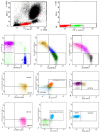Memory T Cells Discrepancies in COVID-19 Patients
- PMID: 38004749
- PMCID: PMC10673271
- DOI: 10.3390/microorganisms11112737
Memory T Cells Discrepancies in COVID-19 Patients
Abstract
The immune response implicated in Coronavirus disease 2019 (COVID-19) pathogenesis remains to be fully understood. The present study aimed to clarify the alterations in CD4+ and CD8+ memory T cells' compartments in SARS-CoV-2-infected patients, with an emphasis on various comorbidities affecting COVID-19 patients. Peripheral blood samples were collected from 35 COVID-19 patients, 16 recovered individuals, and 25 healthy controls, and analyzed using flow cytometry. Significant alterations were detected in the percentage of CD8+ T cells and effector memory-expressing CD45RA CD8+ T cells (TEMRA) in COVID-19 patients compared to healthy controls. Interestingly, altered percentages of CD4+ T cells, CD8+ T cells, T effector (TEff), T naïve cells (TNs), T central memory (TCM), T effector memory (TEM), T stem cell memory (TSCM), and TEMRA T cells were significantly associated with the disease severity. Male patients had more CD8+ TSCMs and CD4+ TNs cells, while female patients had a significantly higher percentage of effector CD8+CD45RA+ T cells. Moreover, altered percentages of CD8+ TNs and memory CD8+CD45RO+ T cells were detected in diabetic and non-diabetic COVID-19 patients, respectively. In summary, this study identified alterations in memory T cells among COVID-19 patients, revealing a sex bias in the percentage of memory T cells. Moreover, COVID-19 severity and comorbidities have been linked to specific subsets of T memory cells which could be used as therapeutic, diagnostic, and protective targets for severe COVID-19.
Keywords: COVID-19; SARS-CoV-2; T cell subtypes; memory T cells.
Conflict of interest statement
The authors declare no conflict of interest.
Figures








Similar articles
-
Emerging role of stem cell memory-like T cell in immune thrombocytopenia.Scand J Immunol. 2019 Mar;89(3):e12739. doi: 10.1111/sji.12739. Epub 2019 Jan 4. Scand J Immunol. 2019. PMID: 30506564
-
The frequency of CD4+ and CD8+ circulating T stem cell memory in type 1 diabetes.Immun Inflamm Dis. 2022 Oct;10(10):e715. doi: 10.1002/iid3.715. Immun Inflamm Dis. 2022. PMID: 36169248 Free PMC article.
-
Predominance of CD137+ And TNF-α Expressing CD8+ Central Memory T Cells in Mild COVID-19 Recovered Patients Upon SARS-CoV-2 Re-Exposure.Immunol Invest. 2024 Oct;53(7):1092-1101. doi: 10.1080/08820139.2024.2376003. Epub 2024 Jul 12. Immunol Invest. 2024. PMID: 38994913
-
Peripheral memory T-cell profile is modified in patients undergoing periodontal management.J Clin Periodontol. 2021 Feb;48(2):249-262. doi: 10.1111/jcpe.13399. Epub 2020 Nov 22. J Clin Periodontol. 2021. PMID: 33131124
-
Current estimates of T cell kinetics in humans.Curr Opin Syst Biol. 2019 Dec;18:77-86. doi: 10.1016/j.coisb.2019.10.002. Curr Opin Syst Biol. 2019. PMID: 31922055 Free PMC article. Review.
Cited by
-
T Cell Peptide Prediction, Immune Response, and Host-Pathogen Relationship in Vaccinated and Recovered from Mild COVID-19 Subjects.Biomolecules. 2024 Sep 26;14(10):1217. doi: 10.3390/biom14101217. Biomolecules. 2024. PMID: 39456150 Free PMC article.
-
Durability of Functional SARS-CoV-2-Specific Immunological Memory and T Cell Response up to 8-9 Months Postrecovery From COVID-19.J Immunol Res. 2025 Feb 10;2025:9743866. doi: 10.1155/jimr/9743866. eCollection 2025. J Immunol Res. 2025. PMID: 39963186 Free PMC article.
-
CD4+ Effective Memory T Cell Markers GBP2 and LAG3 Are Risk Factors for PTB and COVID-19 Infection: A Study Integrating Single-Cell Expression Quantitative Trait Locus and Mendelian Randomization Analyses.Int J Mol Sci. 2024 Sep 16;25(18):9971. doi: 10.3390/ijms25189971. Int J Mol Sci. 2024. PMID: 39337460 Free PMC article.
References
-
- Tso F.Y., Lidenge S.J., Peña P.B., Clegg A.A., Ngowi J.R., Mwaiselage J., Ngalamika O., Julius P., West J.T., Wood C. High prevalence of pre-existing serological cross-reactivity against severe acute respiratory syndrome coronavirus-2 (SARS-CoV-2) in sub-Saharan Africa. Int. J. Infect. Dis. 2021;102:577–583. doi: 10.1016/j.ijid.2020.10.104. - DOI - PMC - PubMed
-
- Malik Y.A. Properties of coronavirus and SARS-CoV-2. Malays. J. Pathol. 2020;42:3–11. - PubMed
-
- Jha N.K., Ojha S., Jha S.K., Dureja H., Singh S.K., Shukla S.D., Chellappan D.K., Gupta G., Bhardwaj S., Kumar N., et al. Evidence of coronavirus (CoV) pathogenesis and emerging pathogen SARS-CoV-2 in the nervous system: A review on neurological impairments and manifestations. J. Mol. Neurosci. 2021;71:2192–2209. doi: 10.1007/s12031-020-01767-6. - DOI - PMC - PubMed
Grants and funding
LinkOut - more resources
Full Text Sources
Research Materials
Miscellaneous

